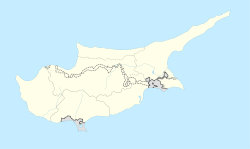Amathus

5th century BC Amathus sarcophagus found in Amathus integrates Greek, Cypriot, and Oriental features
|
|
| Location | Cyprus |
|---|---|
| Region | Limassol District |
| Coordinates | 34°42′45″N 33°08′30″E / 34.71250°N 33.14167°ECoordinates: 34°42′45″N 33°08′30″E / 34.71250°N 33.14167°E |
Amathus (Ancient Greek: ) was one of the most ancient royal cities of Cyprus, on the southern coast in front of Agios Tychonas, about 24 miles west of Larnaca and 6 miles east of Limassol. Its ancient cult of Aphrodite was the most important, after Paphos, in Cyprus, her homeland, though the ruins of Amathus are less well-preserved than neighboring Kourion.
The pre-history of Amathus mixes myth and archaeology. Though there was no Bronze Age city on the site, archaeology has detected human activity that is evident from the earliest Iron Age, c. 1100 BC. The city's legendary founder was Cinyras, linked with the birth of Adonis, who called the city after his mother Amathous. According to a version of the Ariadne legend noted by Plutarch,Theseus abandoned Ariadne at Amathousa, where she died giving birth to her child and was buried in a sacred tomb. According to Plutarch's source, Amathousians called the sacred grove where her shrine was situated the Wood of Aphrodite Ariadne. More purely Hellenic myth would have Amathus settled instead by one of the sons of Heracles, thus accounting for the fact that he was worshiped there.
It was said in antiquity that the people of Amathus were , or "Pelasgian". Their non-Greek language is confirmed on the site by Eteocypriot inscriptions in the Cypriot syllabary which alone in the Aegean world survived the Bronze Age collapse and continued to be used down to the 4th century BC.
Amathus was built on the coastal cliffs with a natural harbor and flourished at an early date, soon requiring several cemeteries. Greeks from Euboea left their pottery at Amathus from the 10th century BC. During the post-Phoenician era of the 8th century BC, a palace was erected and a port was also constructed, which served the trade with the Greeks and the Levantines. A special burial ground for infants, a tophet served the culture of the Phoenicians. For the Hellenes, high on the cliff a temple was built, which became a worship site devoted to Aphrodite, in her particular local presence as Aphrodite Amathusia along with a bearded male Aphrodite called Aphroditos. The excavators discovered the final stage of the Temple of Aphrodite, also known as Aphrodisias, which dates approximately to the 1st century BC. According to the legend, it was where festive Adonia took place, in which athletes competed in hunting wild boars during sport competitions; they also competed in dancing and singing, all to the honour of Adonis.
...
Wikipedia

